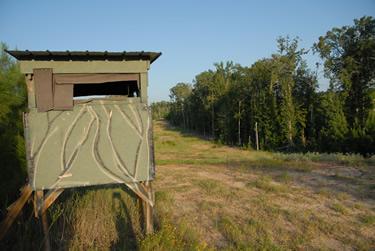 October 6, 2017 - Just about any serious deer hunter will be quick to agree that getting ready for a full season of chasing whitetails can add up to a considerable amount of work. The really hardcore junkies might call it a labor of love, one that is marked by an long chain of sweaty chores that are typically carried out long before the dawn of opening day.
October 6, 2017 - Just about any serious deer hunter will be quick to agree that getting ready for a full season of chasing whitetails can add up to a considerable amount of work. The really hardcore junkies might call it a labor of love, one that is marked by an long chain of sweaty chores that are typically carried out long before the dawn of opening day.
To wit:
The smart hunter is sure to have shooting lanes trimmed or mowed by now. He's already secured new stands and made any needed repairs to old ones. Corn feeders are full and any new feeding stations have been up and running for the better part of month, possibly longer in order to give inherently wary whitetails plenty of time to adjust ahead of the Nov. 4 general season opener.
Another pre-season chore frequently carried out on deer leases and hunting clubs across Texas this time of year involves planting fall food plots utilizing any number blends and mixes that do well in cool weather.
Once established, fall and winter cover crops like gulf rye, oats, clover, wheat, Austrian winter peas, cowpeas, etc…. perform double duty by benefitting hunters as well as deer and other wildlife.
For starters, food plots boost the odds of luring deer into the open for evaluation and possible harvest, especially late in the season after their natural food supplies have been exhausted. More importantly, they provide great sources of critical nutrition to carry animals through the harshest part of winter and early spring, when other food supplies are hard to come by.
There's an art to planting food plots, and much of it revolves around timing. Some land managers like to get a jump on things and do their planting in early September, often around the Labor Day holiday.
That might be alright for small leases involving just a couple plots or during years when there is sufficient ground moisture jump start the germination process. Just be aware that planting early can be financially risky business if you're sowing a lot of seed, mainly because cereal grains and legumes don't come cheap.
Plant too early and there's a good chance the weather could turn off oppressively hot and dry. This could kill young, immature plants before they have the opportunity to become established, or prevent them from germinating altogether.
For that reason, some wildlife managers around eastern Texas have told me that it's a good idea to wait until until late September or early October to put seed in the ground. That way the risk of crop failure is greatly reduced.
Dr. Billy Higginbotham knows a thing or two about planting fall and winter food plots. Higginbotham is a professor emeritus with the Texas A&M AgriLife Research and Extension Center in Overton. He's been working closely with landowners and land managers around eastern Texas in all areas of wildlife and fisheries management for decades.
According to Higginbotham, the first order business to be tackled before planting any cool season food plot is make sure the soil contains the proper goodies to spur optimum growth. That means having the soil tested to determine the existing pH level.
Soil tests can be performed at a minimal cost through soil labs at SFA and Texas A&M universities. Local county extension offices can point you in the right direction to get it done.
"Soil tests are necessary to determine if agricultural lime is needed to correct low pH levels and to allow landowners to customize fertilizer applications based on the varieties of plants established," says Higginbotham. "This simple step can mean the difference in abundant forage production or food plots that fail to justify establishment costs."
Ideally, soil testing should be performed prior to the planting date to allow time to make any amendments to the soil content that may be needed, Higginbotham added.
The next step is prepping the ground. While some cereal grains like rye and oats will germinate on top of the ground given sufficient moisture, you will achieve much better results by breaking up the ground by tilling or discing, then dragging lightly to cover the seed with a thin layer of soil.
The Best Mix
Some deer managers prefer to take the easy street and plant some sort of cereal grain like oats or rye because they are simple to distribute and fairly easy to get established with a little moisture. But if your objective is to do deer and other wildlife some good over the long term, offer them a nutritional buffet as opposed to one main course.
Higginbotham is a big fan of offering deer some variety. One his favorite combinations is a generous blend of iron and clay cowpeas at seeding rate of about 40 pounds per acre, a winter hardy oat variety at 40 pounds per acre and arrowleaf clover at a rate of about 10 pounds per acre.
The biologist said it is important to note that cowpeas and clover are legumes. The seeds must be inoculated using the proper inoculate. The inoculate helps the plant develop nodules, which in turn produce the nitrogen that spurs plant growth and helps achieve maximum production throughout the growth period.
"If all three varieties are utilized, it is important to plant the oats and peas first, covering them to a depth of about one inch," Higginbotham said. "The clover seed can then be distributed and lightly dragged in just deep enough to cover the seed. Planting seed too deep has led to many food plot failures."
Once the seeds are in the ground, Higginbotham said cowpeas are usually the first to begin showing signs of life.
"Within a week of planting, the cowpeas will literally jump out of the ground and serve to hold the deer until the oats can germinate and grow," he said. "While the peas will disappear under heavy use or with the first freeze, the oats will provide forage up until the spring green-up, at which time the arrowleaf clover comes on strong and remains available well into June."
Another combination Higginbotham likes in East Texas is a combination of chicory seeded at about 10 pounds per acre and winter hardy oats seeded at 100 pounds per acre. He recommends seeding and covering the oats about one inch deep, then overseeding and lightly covering the chicory.
Fertilization
Cereal grains and legumes will germinate and grow without fertilization, but not near as good as they will when peppered with a good fertilizer containing the proper percentages of nitrogen, phosphorus and potassium. Soil testing will determine the proper fertilization rate. A rate of 200-300 pounds per acre is fairly common. It's hard to go wrong with a 13-13-13 fertilizer.
The Right Size, Shape
As a rule, its best to have several small food plots scattered around the property as opposed to one or two big ones. The best food plots are those that are long and linear in shape. Roads, pipeline and power line crossings are ideal.
Of course, not all leases have the luxury of having access to pipeline and powerline crossings. In such a case, old log sets, open fields bordering timber stands and logging road intersections make good locations for food plots so long as ample sunlight can reach the ground. It's also a good idea to make sure food plots are fairly centralized, well away from fence boundaries.
Matt Williams is a freelance writer based in Nacogdoches. He can be reached by e-mail, mattwillwrite4u@yahoo.com.









